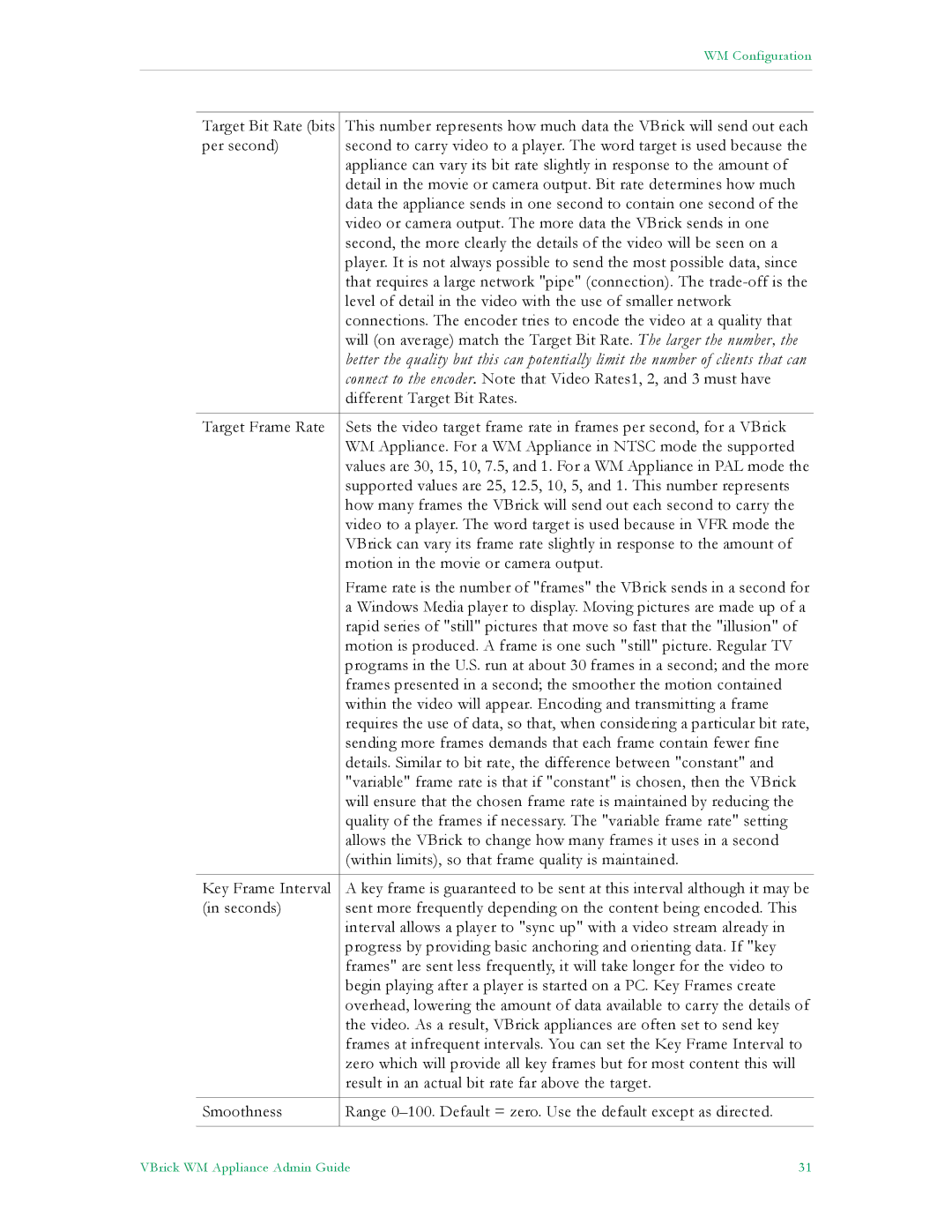|
| WM Configuration |
|
|
|
|
|
|
|
|
|
| Target Bit Rate (bits | This number represents how much data the VBrick will send out each |
|
| per second) | second to carry video to a player. The word target is used because the |
|
|
| appliance can vary its bit rate slightly in response to the amount of |
|
|
| detail in the movie or camera output. Bit rate determines how much |
|
|
| data the appliance sends in one second to contain one second of the |
|
|
| video or camera output. The more data the VBrick sends in one |
|
|
| second, the more clearly the details of the video will be seen on a |
|
|
| player. It is not always possible to send the most possible data, since |
|
|
| that requires a large network "pipe" (connection). The |
|
|
| level of detail in the video with the use of smaller network |
|
|
| connections. The encoder tries to encode the video at a quality that |
|
|
| will (on average) match the Target Bit Rate. The larger the number, the |
|
|
| better the quality but this can potentially limit the number of clients that can |
|
|
| connect to the encoder. Note that Video Rates1, 2, and 3 must have |
|
|
| different Target Bit Rates. |
|
|
|
|
|
| Target Frame Rate | Sets the video target frame rate in frames per second, for a VBrick |
|
|
| WM Appliance. For a WM Appliance in NTSC mode the supported |
|
|
| values are 30, 15, 10, 7.5, and 1. For a WM Appliance in PAL mode the |
|
|
| supported values are 25, 12.5, 10, 5, and 1. This number represents |
|
|
| how many frames the VBrick will send out each second to carry the |
|
|
| video to a player. The word target is used because in VFR mode the |
|
|
| VBrick can vary its frame rate slightly in response to the amount of |
|
|
| motion in the movie or camera output. |
|
|
| Frame rate is the number of "frames" the VBrick sends in a second for |
|
|
| a Windows Media player to display. Moving pictures are made up of a |
|
|
| rapid series of "still" pictures that move so fast that the "illusion" of |
|
|
| motion is produced. A frame is one such "still" picture. Regular TV |
|
|
| programs in the U.S. run at about 30 frames in a second; and the more |
|
|
| frames presented in a second; the smoother the motion contained |
|
|
| within the video will appear. Encoding and transmitting a frame |
|
|
| requires the use of data, so that, when considering a particular bit rate, |
|
|
| sending more frames demands that each frame contain fewer fine |
|
|
| details. Similar to bit rate, the difference between "constant" and |
|
|
| "variable" frame rate is that if "constant" is chosen, then the VBrick |
|
|
| will ensure that the chosen frame rate is maintained by reducing the |
|
|
| quality of the frames if necessary. The "variable frame rate" setting |
|
|
| allows the VBrick to change how many frames it uses in a second |
|
|
| (within limits), so that frame quality is maintained. |
|
|
|
|
|
| Key Frame Interval | A key frame is guaranteed to be sent at this interval although it may be |
|
| (in seconds) | sent more frequently depending on the content being encoded. This |
|
|
| interval allows a player to "sync up" with a video stream already in |
|
|
| progress by providing basic anchoring and orienting data. If "key |
|
|
| frames" are sent less frequently, it will take longer for the video to |
|
|
| begin playing after a player is started on a PC. Key Frames create |
|
|
| overhead, lowering the amount of data available to carry the details of |
|
|
| the video. As a result, VBrick appliances are often set to send key |
|
|
| frames at infrequent intervals. You can set the Key Frame Interval to |
|
|
| zero which will provide all key frames but for most content this will |
|
|
| result in an actual bit rate far above the target. |
|
|
|
|
|
| Smoothness | Range |
|
|
|
|
|
VBrick WM Appliance Admin Guide | 31 |
